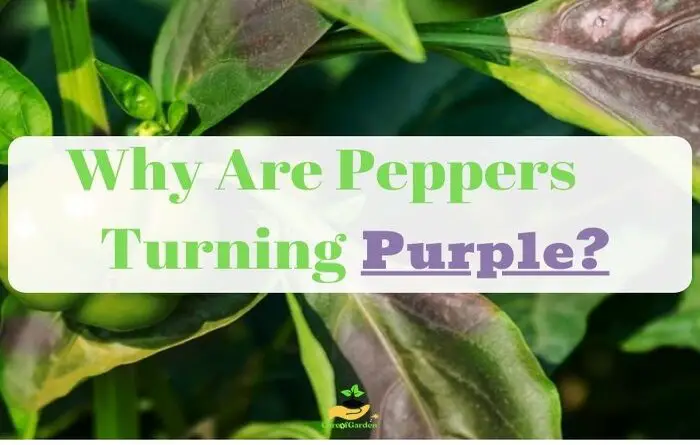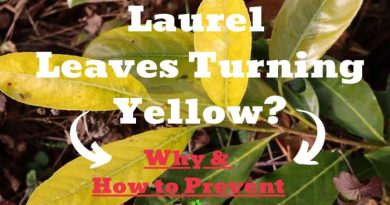Why are Peppers Turning Purple? (4 Causes & Solutions)
Why are Peppers Turning Purple? Why do peppers have purple leaves? This questions are most often faced by many gardeners. To cure the peppers, you need to understand the reasons why they turn purple.
It is vital to figure out exactly why the pepper leaves turn purple in order to start the correct treatment of the plant.
Causes of Peppers Turning Purple
| Causes of Peppers Turning Purple |
|---|
| 1. Phosphorus deficiency |
| 2. Low Temperature |
| 3. Lack of water |
| 4. Crop rotation errors |
1. Phosphorus deficiency
The primary reason why peppers turns purple is the lack of phosphorus (phosphorus deficiency). Phosphorus is one of the essential nutrients for good plant health. If your plants are showing signs of a phosphorus deficiency, it is important to check the phosphor levels in your soil immediately.
In the case of phosphorus deficiency, the older (lower) pepper seedling leaves first acquire a purple color (since phosphorus itself is not very mobile), and then the younger (upper) leaves, which also gradually turn purple.
Phosphorus is responsible for the control of constant metabolic processes and serves as a source of energy for pepper. During pepper seed germination, this trace element enhances root growth, accelerates the onset of flowering and fruit ripening.
In addition, phosphorus increases sugar content and increases the amount of pulp, significantly increasing yields.
The lack of phosphorus is caused by the underdevelopment of the root system, which cannot assimilate the required amount of phosphorus for various reasons. This may be low temperature of both the soil and the environment, as well as an acidic or alkaline reaction of the soil solution when phosphorus is blocked in the soil.
To fertilize pepper plants use:
- superphosphate fertilizer at the rate of 600 g per 1 sq. m;
- 200 g of ash per 1 sq. m;
- a bucket of compost per bush;
- 80 g of potassium sulfate per 1 sq. m.
Here is the answer for this common question: Do Pepper Plants like Coffee Grounds?
2. Low Temperature
The second cause why peppers are turning purple is the freezing of seedlings due to cool temperatures. Peppers love a certain temperature, and if it drops to 59°F( 15°C) or lower, they immediately signal this by turning leaves purple. After all, the lowered temperature of the soil prevents the normal absorption of phosphorus and nitrogen from the soil by the plant.
Cold conditions usually cause plants to temporarily pause production of chlorophyll (the green pigment in plants). This happens naturally in the fall, causing the pepper leaves to become purple.
Pepper does not accept sudden changes in temperature. The plant “colds” easily, and a change in the color of the leaves from green to purple can be a reaction to the wrong climate. Then the leaves roll up into a tube and dry.
The pepper is very sensitive to variations in temperature and brightness; the optimum vegetation is achieved with temperatures equal to 78°F (26°C) during the day and 60°F (16°C) at night, while, in low light conditions, the values drop to 68°F (20°C) during the day and 58°F (14 °C) at night.
It is recommended to maintain the room temperature before germination at about 25 degrees C, after germination up to 20 degrees C during the day, up to 16 degrees C at night. If a purple hue appears, the pepper seedlings should be placed in a warmer place and the color is restored.
It’s most likely a temperature issue. This is where the under-fertilization comes from. To put it simply, the plant absorbs fewer (different) nutrients when it is cold. If you have no way of increasing the temperature by heating using infrared lamps.
3. Lack of water
Often the pepper leaves will turn purple if they lack water or moisture because dehydration will prevent the pepper from absorbing the necessary nutrients. If the lower leaves are stained purple at the very beginning, this indicates that the plant lacks minerals.
Peppers are moisture-loving plants, with a lack of moisture in the soil beds, the metabolism in plants slows down, the leaves turn lilac, then purple, curl, veins appear on them, and they dry out.
With a lack of water from the soil, the plant does not receive the necessary nutrition, nutrients do not enter the pepper stem and leaves.
Pepper does not tolerate drought, the plant withers and biological processes are suspended. Peppers need to be watered often, thoroughly wetting the earthen ball.
It is important, both in the open field and in the greenhouse, to regularly carry out sufficient watering, accompanying the procedure of loosening.
Then the soil must be loosened, so evaporation slows down and prevents the soil from drying out. The amount of water should be sufficient, but not excessive, otherwise stagnation of water near the roots will lead to rot.
Stagnation of water in the roots of pepper plants must be avoided. Excessive watering is detrimental to plants.
It is necessary to use warm water warmed up during the day by the suns rays, irrigating directly to the root system and preventing water from entering the aerial part of the plant.
4. Crop rotation error
Planting peppers in the same place for several years in a row will deplete the soil of the nutrients and minerals required for growth. Thus crop rotation is required in order for the nutritional needs of the peppers to be fulfilled, one of the most important one being phosphorus, nitrogen and calcium.
Peppers can have purple color because of crop rotation errors that gardeners make. Pepper can change color and wither due to a lack of trace elements, because previous crops used them.
The crop rotation allows you to:
- avoid the phenomena of soil fatigue;
- increase soil fertility;
- influence the soil structure;
For the cultivation of peppers it is very important to evaluate the characteristics of the soil: the crop cannot be grown in compact soils that have low oxygen.
Pepper root system have a low exchange capacity and therefore require fresh or generally loose medium-textured soils that guarantee good drainage and keep their structure and porosity sufficiently stable over time.
For example, crops from genus Solanaceae (potato family) absorb phosphorus, which is important for pepper, and thus cause the appearance of purple spots.
It is therefore advisable to include other plant families in the rotation: in particular the most favorable crop precessions are those with Liliaceae (onion, garlic) and grain legumes.
| Crop Cultivated | Crop Allowed |
|---|---|
| Bell Pepper | Cucumbers |
| Tomatoes | Potato |
| Eggplant | Carrots |
How to Prevent Peppers from Turning Purple
If, when growing bell peppers, you suddenly happen to find an unusual purple hue in its leaves, then you don’t have to worry much. Knowing the causes of this phenomenon and methods for its elimination, it is possible to return the pepper to its normal appearance, which means health.
This will subsequently allow you to enjoy the delicious, juicy, fragrant fruits of bell pepper.
To prevent pepper from turning purple follow this steps:
- maintain a temperature of 64-68°F (18-20℃) in the greenhouse;
- cover the outside pepper seedlings with nylon during cold weather;
- apply phosphorus-containing fertilizers when peppers grow;
- fertilize the soil with organic matter (7 kg of manure, bird droppings or compost and 40 g of superphosphate per square meter of planting area);
- water the seedlings using a drip system;
- regularly remove weeds that can interfere with the growth of pepper.
Conclusion
Purple spots on peppers are a signal for gardeners, requiring attention and decisive action. If at first the cause of the problem is determined, the conditions of nutrition, water and temperature are fixed, the pepper will quickly return to its former green color.




